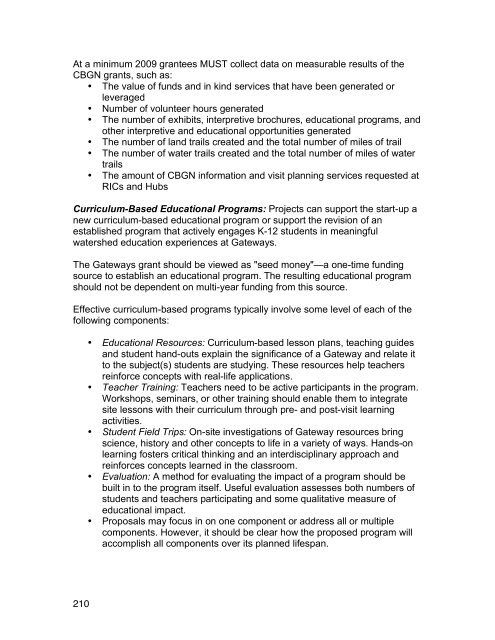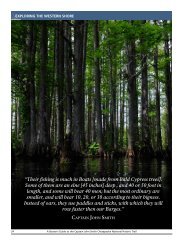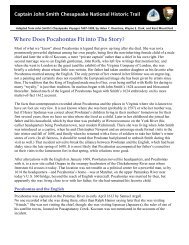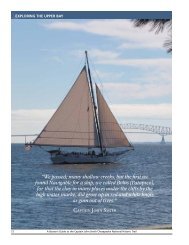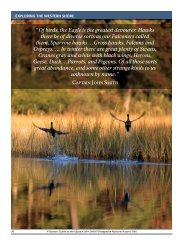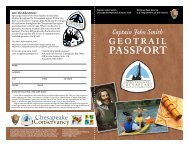Draft Interpretive Plan Join the adventure! - Captain John Smith ...
Draft Interpretive Plan Join the adventure! - Captain John Smith ...
Draft Interpretive Plan Join the adventure! - Captain John Smith ...
You also want an ePaper? Increase the reach of your titles
YUMPU automatically turns print PDFs into web optimized ePapers that Google loves.
At a minimum 2009 grantees MUST collect data on measurable results of <strong>the</strong><br />
CBGN grants, such as:<br />
• The value of funds and in kind services that have been generated or<br />
leveraged<br />
• Number of volunteer hours generated<br />
• The number of exhibits, interpretive brochures, educational programs, and<br />
o<strong>the</strong>r interpretive and educational opportunities generated<br />
• The number of land trails created and <strong>the</strong> total number of miles of trail<br />
• The number of water trails created and <strong>the</strong> total number of miles of water<br />
trails<br />
• The amount of CBGN information and visit planning services requested at<br />
RICs and Hubs<br />
Curriculum-Based Educational Programs: Projects can support <strong>the</strong> start-up a<br />
new curriculum-based educational program or support <strong>the</strong> revision of an<br />
established program that actively engages K-12 students in meaningful<br />
watershed education experiences at Gateways.<br />
The Gateways grant should be viewed as "seed money"—a one-time funding<br />
source to establish an educational program. The resulting educational program<br />
should not be dependent on multi-year funding from this source.<br />
Effective curriculum-based programs typically involve some level of each of <strong>the</strong><br />
following components:<br />
• Educational Resources: Curriculum-based lesson plans, teaching guides<br />
and student hand-outs explain <strong>the</strong> significance of a Gateway and relate it<br />
to <strong>the</strong> subject(s) students are studying. These resources help teachers<br />
reinforce concepts with real-life applications.<br />
• Teacher Training: Teachers need to be active participants in <strong>the</strong> program.<br />
Workshops, seminars, or o<strong>the</strong>r training should enable <strong>the</strong>m to integrate<br />
site lessons with <strong>the</strong>ir curriculum through pre- and post-visit learning<br />
activities.<br />
• Student Field Trips: On-site investigations of Gateway resources bring<br />
science, history and o<strong>the</strong>r concepts to life in a variety of ways. Hands-on<br />
learning fosters critical thinking and an interdisciplinary approach and<br />
reinforces concepts learned in <strong>the</strong> classroom.<br />
• Evaluation: A method for evaluating <strong>the</strong> impact of a program should be<br />
built in to <strong>the</strong> program itself. Useful evaluation assesses both numbers of<br />
students and teachers participating and some qualitative measure of<br />
educational impact.<br />
• Proposals may focus in on one component or address all or multiple<br />
components. However, it should be clear how <strong>the</strong> proposed program will<br />
accomplish all components over its planned lifespan.<br />
210


